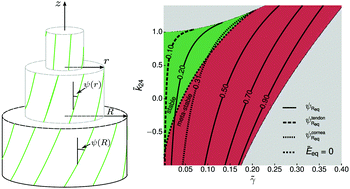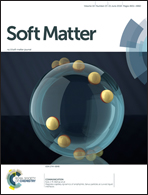Polymorphism of stable collagen fibrils
Abstract
Collagen fibrils are versatile self-assembled structures that provide mechanical integrity within mammalian tissues. The radius of collagen fibrils vary widely depending on experimental conditions in vitro or anatomical location in vivo. Here we explore the variety of thermodynamically stable fibril configurations that are available. We use a liquid crystal model of radial collagen fibril structure with a double-twist director field. Using a numerical relaxation method we show that two dimensionless parameters, the ratio of saddle-splay to twist elastic constants k24/K22 and the ratio of surface tension to chiral strength ![[small gamma, Greek, tilde]](https://www.rsc.org/images/entities/i_char_e0dd.gif) ≡ γ/(K22q), largely specify both the scaled fibril radius and the associated surface twist of equilibrium fibrils. We find that collagen fibrils are the stable phase with respect to the cholesteric phase only when the reduced surface tension is small,
≡ γ/(K22q), largely specify both the scaled fibril radius and the associated surface twist of equilibrium fibrils. We find that collagen fibrils are the stable phase with respect to the cholesteric phase only when the reduced surface tension is small, ![[small gamma, Greek, tilde]](https://www.rsc.org/images/entities/i_char_e0dd.gif) ≲ 0.2. Within this stable regime, collagen fibrils can access a wide range of radii and associated surface twists. Remarkably, we find a maximal equilibrium surface twist of 0.33 rad (19°). Our results are compatible with corneal collagen fibrils, and we show how the large surface twist can explain the narrow distribution of corneal fibril radii. Conversely, we show how small surface twist is required for the thermodynamic stability of tendon fibrils in the face of considerable polydispersity of radius.
≲ 0.2. Within this stable regime, collagen fibrils can access a wide range of radii and associated surface twists. Remarkably, we find a maximal equilibrium surface twist of 0.33 rad (19°). Our results are compatible with corneal collagen fibrils, and we show how the large surface twist can explain the narrow distribution of corneal fibril radii. Conversely, we show how small surface twist is required for the thermodynamic stability of tendon fibrils in the face of considerable polydispersity of radius.



 Please wait while we load your content...
Please wait while we load your content...